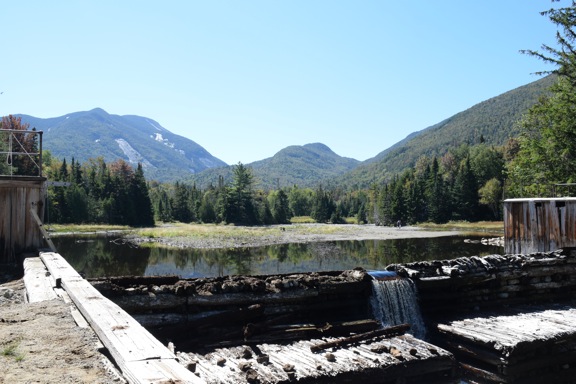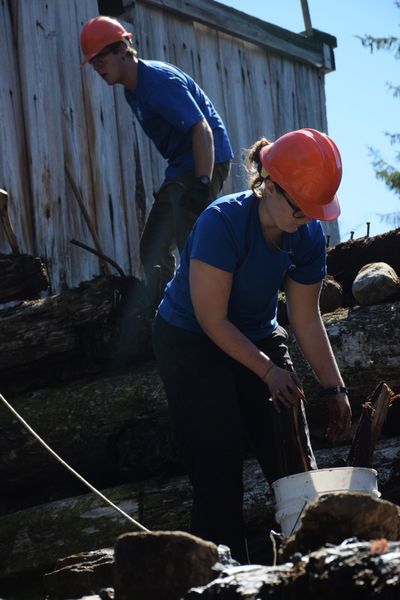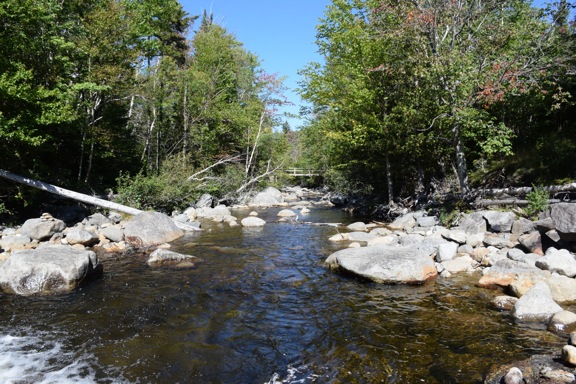Crew begins taking down Marcy Dam

A work crew work began dismantling the top tier of Marcy Dam Tuesday, Sept. 15. (News photo — Shaun Kittle)
LAKE PLACID – An iconic High Peaks vantage point is vanishing.
A work crew began a five-year process this week to remove Marcy Dam, which was damaged during Tropical Storm Irene in 2011, causing the pond above it to drain.
The dam across Marcy Brook is located along the Van Hoevenberg Trail, which begins at the back of the High Peaks Information Center parking lot near Lake Placid and continues to the summit of the 5,344-foot Mount Marcy. The dam is also the endpoint of a truck trail from South Meadow Road. After Irene’s blast of water, state officials decided the dam would be too expensive to repair and called for its removal.
Led by Tate Connor, the High Peaks Wilderness Area manager with the state Department of Environmental Conservation, a crew of Student Conservation Association interns are spending the week removing metal railings, splash boards, top rocks for the first tier, first-tier crib pieces and vertical side boards from the walls below the spillway.
Motors can’t be used in the High Peaks, so some portions of the structure, like the splash boards, will be removed using hand tools while others, like the vertical side boards, will be lifted off of the dam using a high line.

Student Conservation Association intern Victoria Challingsworth collects loose pieces of wood Tuesday, Sept. 15 from the top of Marcy Dam. (News photo — Shaun Kittle)
The high line is two steel tripods, one on each side of the dam, with a rope strung between. Slack in the rope causes it to lower so workers can hook large materials that can’t easily be carried, like wooden beams. Removing the slack from the rope makes the materials rise, and a pulley enables someone to move it safely to shore.
“We’re taking the top 18 inches off of the dam and bringing it to the low-water level of the spillway,” Connor said. “Next year we’ll drop it down some more, so it will gradually naturalize. We don’t want to take it down all at once because it would flood out.”
After the second year, Connor said the department will assess if more needs to be done.
Connor said there are no plans to build a bridge where the dam used to be. He expects hikers will be able to easily cross the stream in several years, and a wooden bridge constructed after Irene that’s just downstream from Marcy Dam will serve as a high-water bridge.
“Either way, I’m not making any moves on the trail until this is finalized,” Connor said.

Marcy Brook flows downstream from the dam. (News photo — Shaun Kittle)
When the SCA interns aren’t removing dams, they’re busy doing other projects in the High Peaks, like building bridges, installing rock water bars and moving latrines.
Virginia resident and SCA intern Chaz Langston said it’s his first time in the Adirondacks.
“I’m from the Blue Ridge Mountains, which are like little foothills compared to this,” Langston said. “This work is challenging, but it’s fun. Rain or shine, we’re out here.”
Victoria Challingsworth of St. Mary’s, Pennsylvania, is in the midst of her second SCA internship in the High Peaks. She’s done backcountry education programs, and she also helped create the new trail up Hurricane Mountain.
“It’s really an icon of the Adirondacks, in a way, but it’s also an interesting process and I’ll be able to say I was a part of it,” Challingsworth said. “I think it’s for the best.”
Buffalo resident Morgan Perlette agreed. He was hiking through the area on Tuesday, Sept. 15 and said he visits the region at least twice a year.
“I like the fact that they’re getting rid of it,” Perlette said. “It’s a lot of restriction on the water flow, and you get a lot of buildup with the sediment, which isn’t good for the ecosystem.”
Marcy Dam was originally used for log drives and was rebuilt in 1934 and again in 1971, a year before the State Land Master Plan would make the dam a non-conforming structure in what would be designated as a wilderness area.
In January 2014, when the DEC announced its decision to take down the dam, it said its purpose at this point was “almost wholly aesthetic.” DEC said the dam blocked fish from traveling upstream and would be expensive to rebuild, and that the principles of “wilderness management include allowing rivers and streams to flow unfettered.”
- Student Conservation Association intern Victoria Challingsworth collects loose pieces of wood Tuesday, Sept. 15 from the top of Marcy Dam. (News photo — Shaun Kittle)
- Marcy Brook flows downstream from the dam. (News photo — Shaun Kittle)




